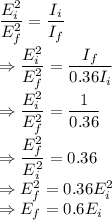
Oxygenated hemoglobin absorbs weakly in the red (hence its red color) and strongly in the near infrared, whereas deoxygenated hemoglobin has the opposite absorption. This fact is used in a "pulse oximeter" to measure oxygen saturation in arterial blood. The device clips onto the end of a person's finger and has two light-emitting diodes—a red (653 nm) and an infrared (935 nm)—and a photocell that detects the amount of light transmitted through the finger at each wavelength.
If 64% of the energy of the red source is absorbed in the blood, by what factor does the amplitude of the electromagnetic wave change?

Answers: 1


Other questions on the subject: Physics

Physics, 21.06.2019 22:30, leannamat2106
According to the tide table below what time of day will the highest tide occur?
Answers: 1

Physics, 22.06.2019 03:30, ashah1260
Starting with only the balmer series light (visible light), how could we ensure that the solar panels generate a current that mark can use for his power station? a)by gradually increasing the brightness (amount) of light that we shine on it. b)by gradually increasing the frequency of the light we shine on it. c)by gradually increasing the wavelength of the light that we shine on it.
Answers: 3


Physics, 22.06.2019 18:00, Zaydblackwood06
The photo shows sugar dissolved into a solution with excess sugar at the bottom of the jar this type of solution is classified as a. unsaturated b. compound c. saturated d. plasma
Answers: 1
You know the right answer?
Oxygenated hemoglobin absorbs weakly in the red (hence its red color) and strongly in the near infra...
Questions in other subjects:





Mathematics, 25.10.2021 14:00


Biology, 25.10.2021 14:00


Chemistry, 25.10.2021 14:00

 = Initial intensity
= Initial intensity



